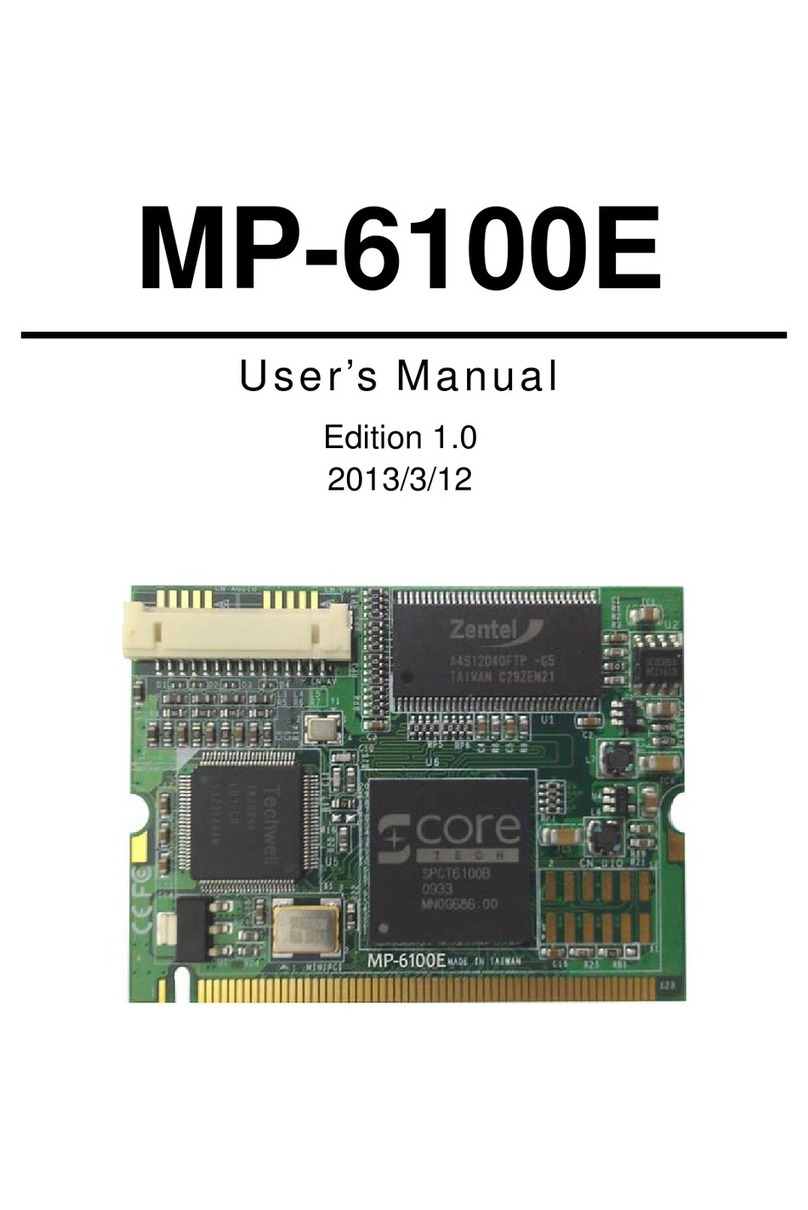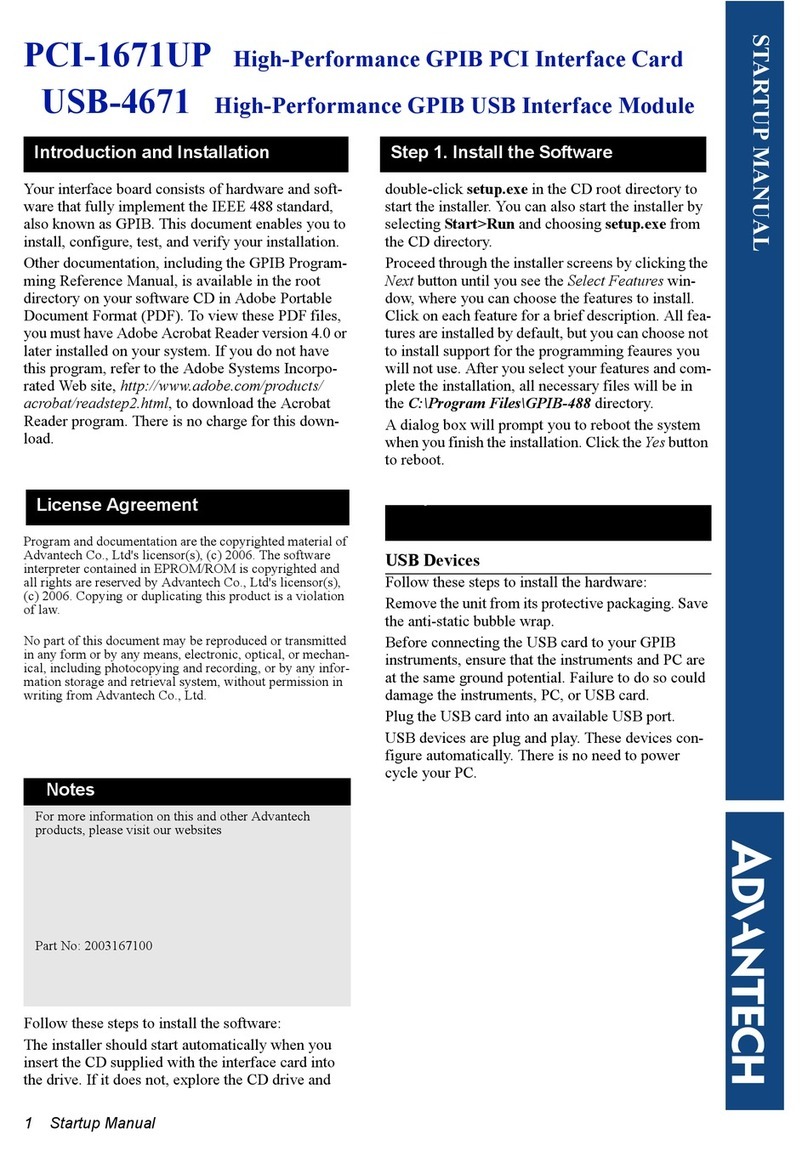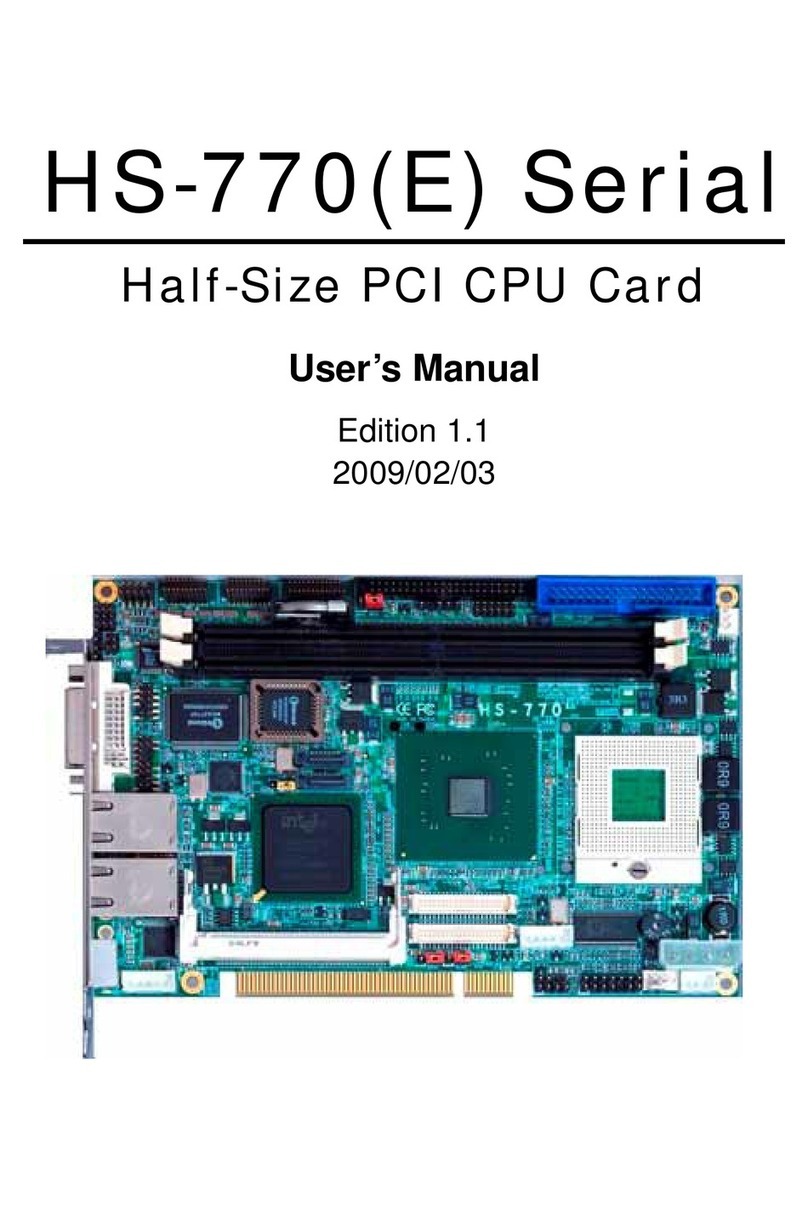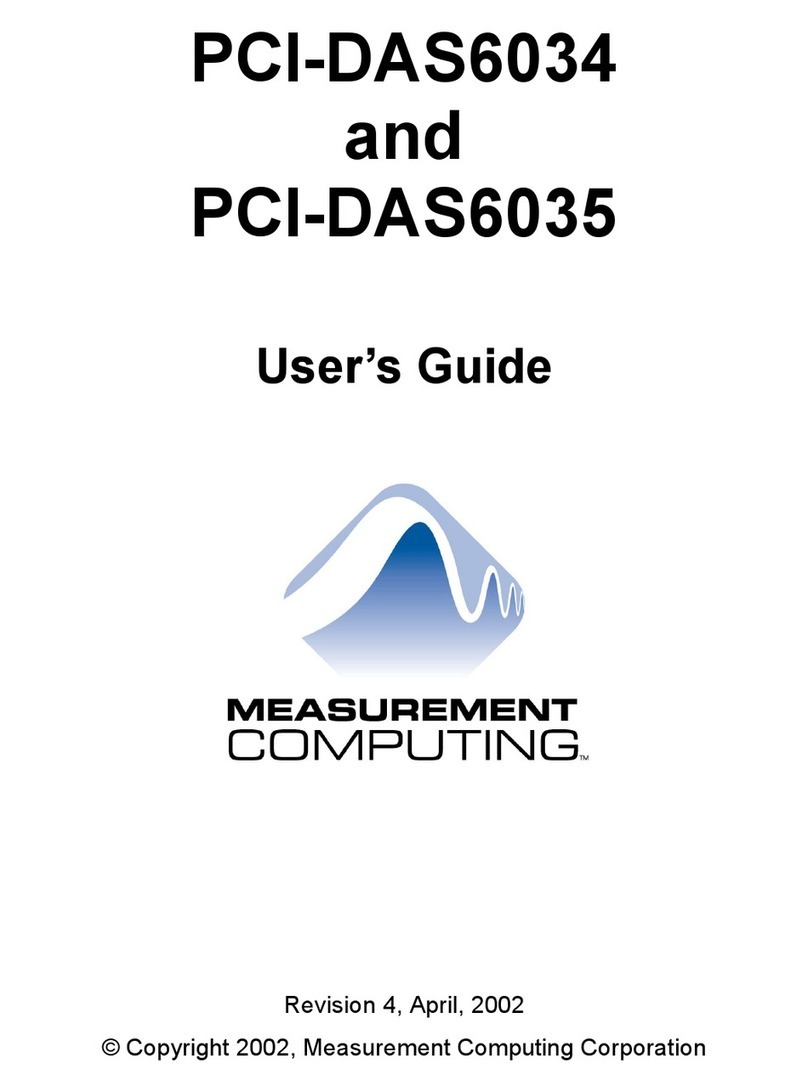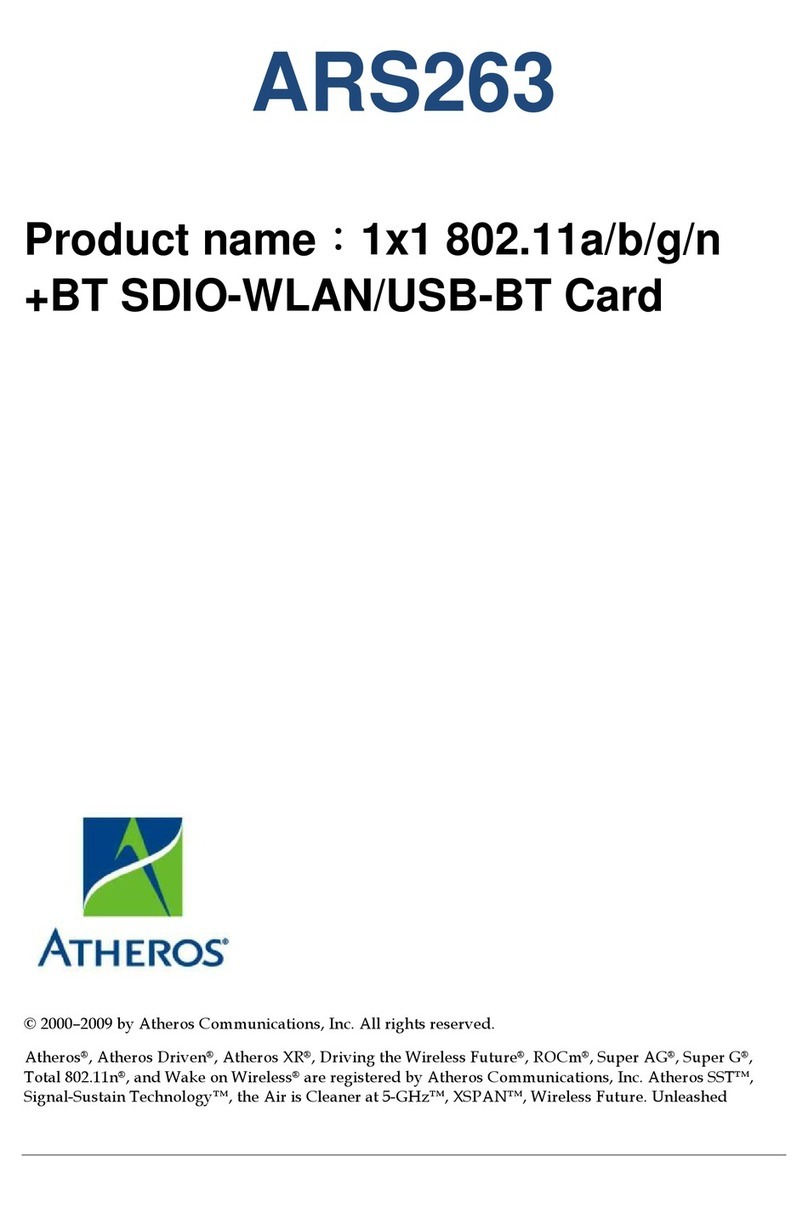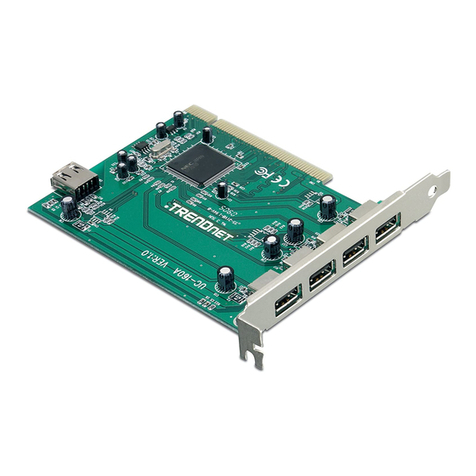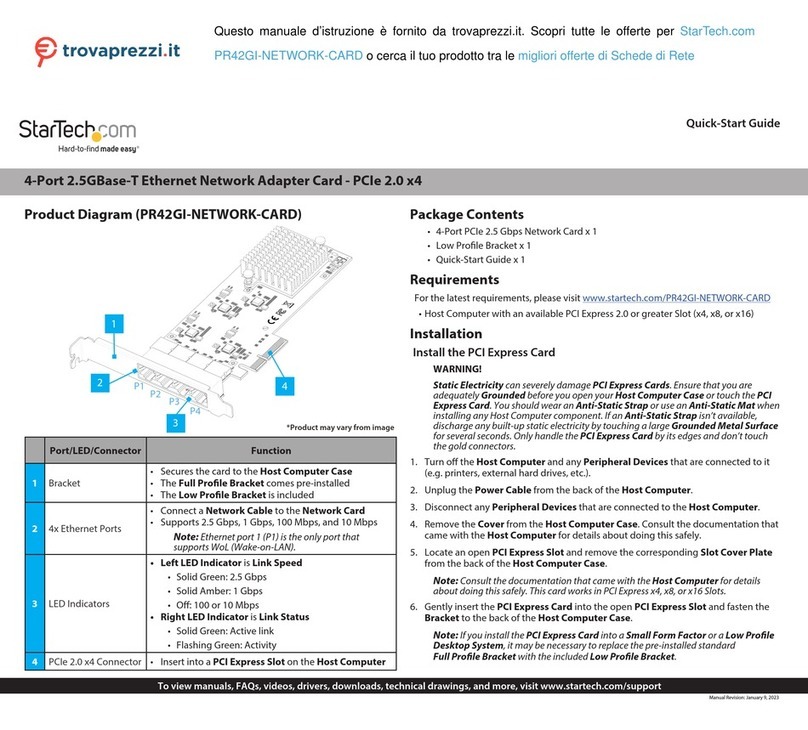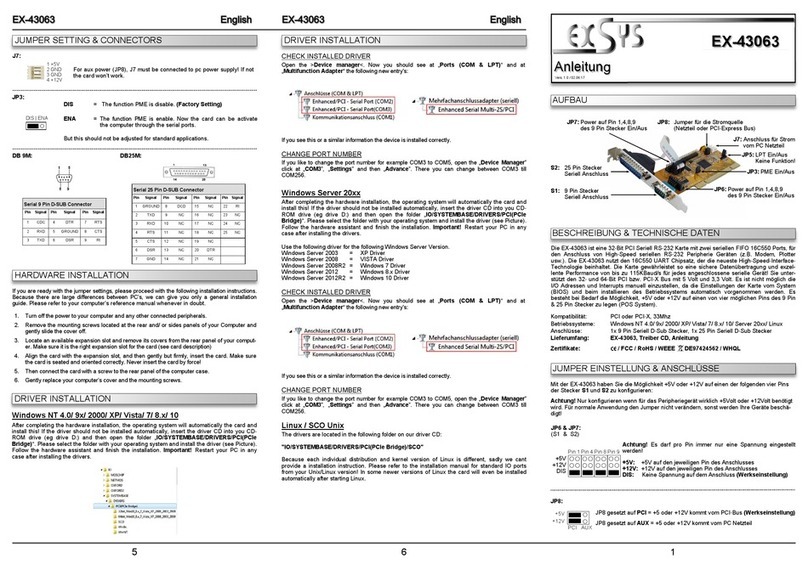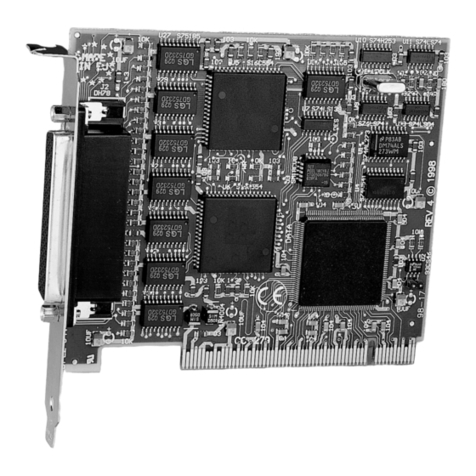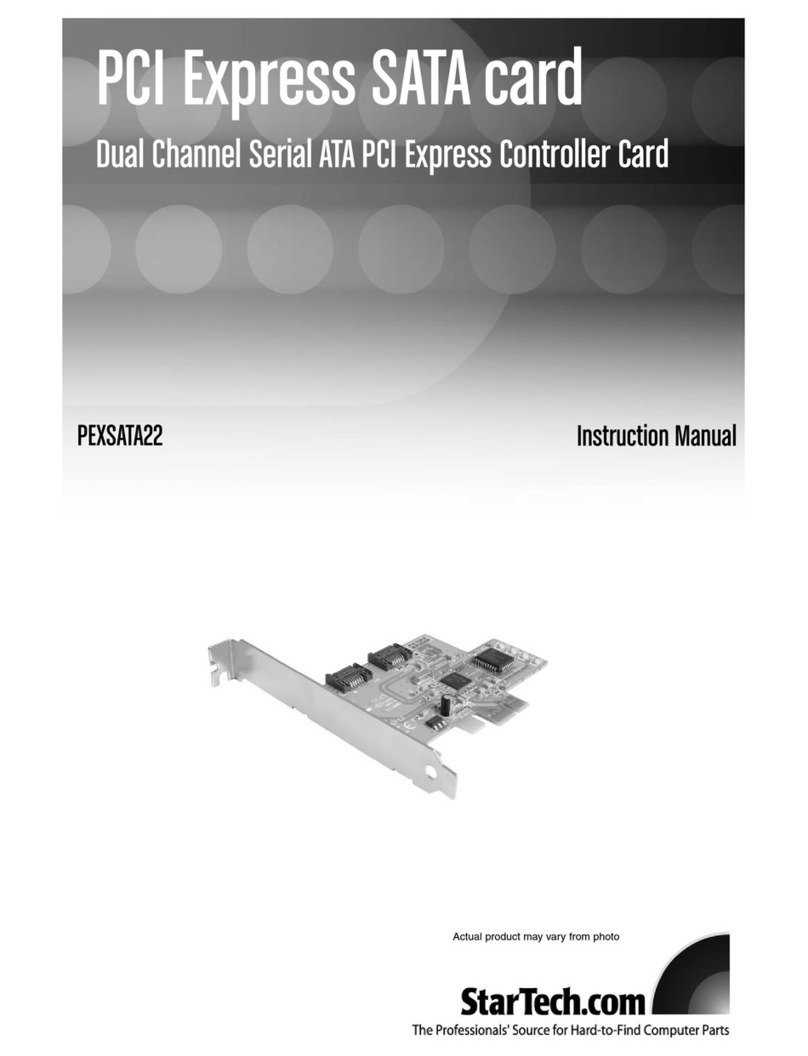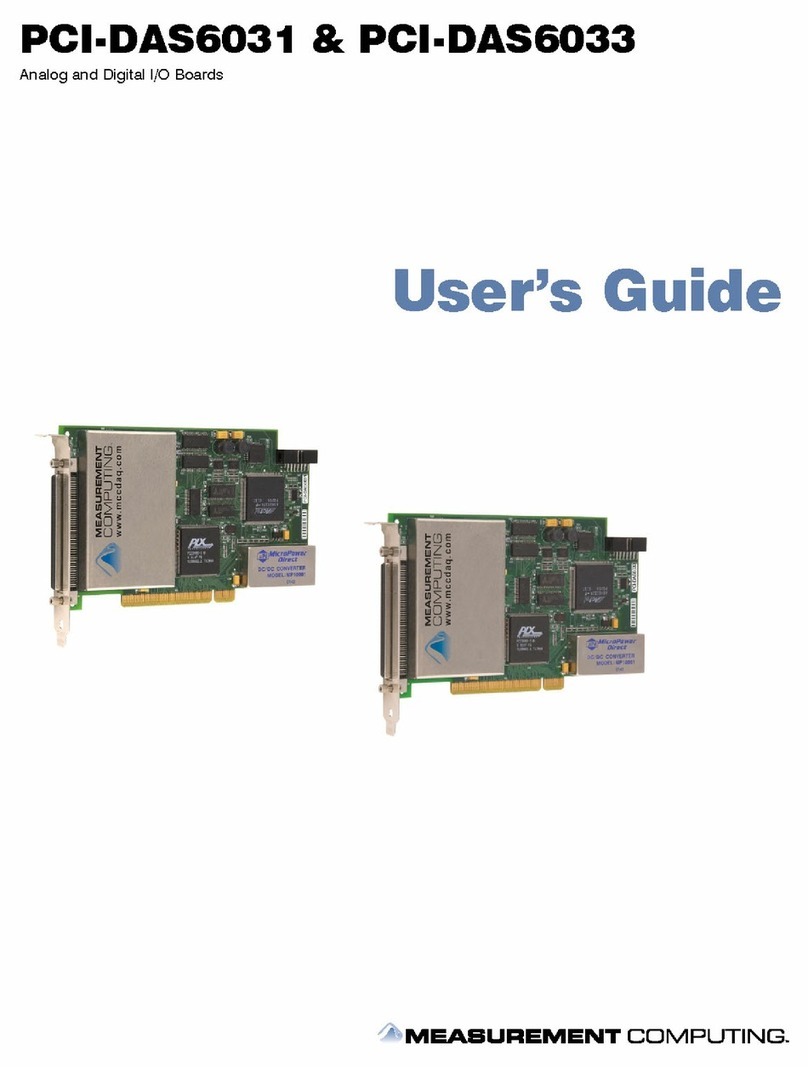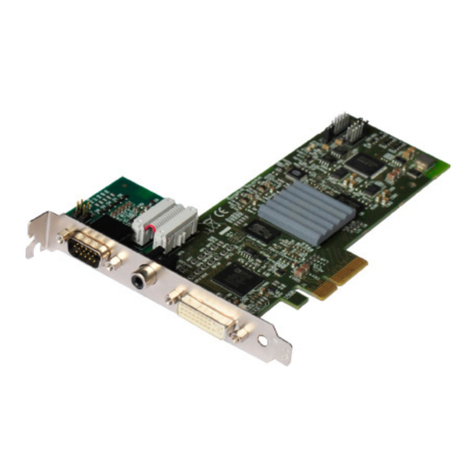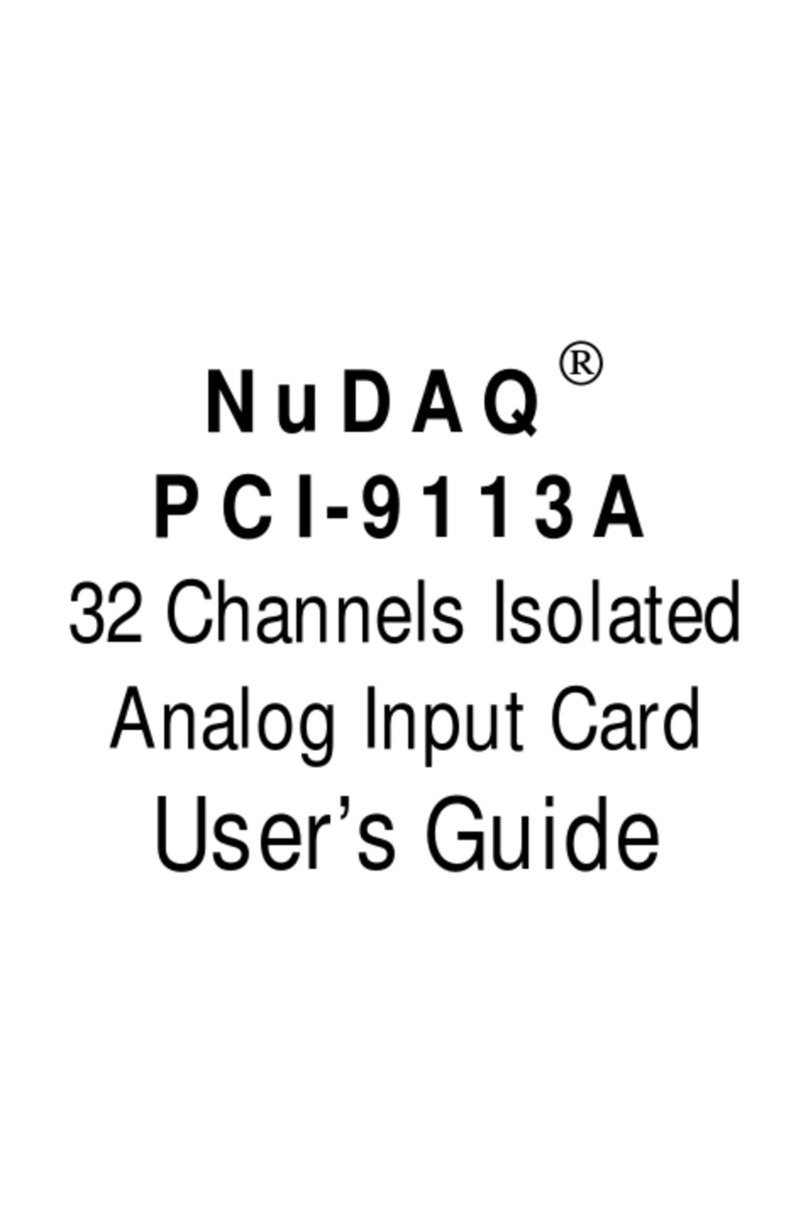Steinberg NUENDO Audiolink 96 User manual


NUENDOAUDIOLINK96
ii
Table of Contents
1. Introduction........................................................................................................6
2. Package Contents.............................................................................................7
3. System Requirements......................................................................................7
4. Brief Description and Characteristics.........................................................8
5. Technical Specifications .................................................................................8
6. Hardware Installation ...................................................................................12
7. Software Installation.....................................................................................13
8. Operation and Usage....................................................................................16
9. Configuring the Digiset or Multiset.........................................................24
10. Word Clock.....................................................................................................37
11. Using more than one Nuendo Audiolink 96......................................39
12. Special Characteristics of the S/P-DIF Output...................................39
13. Operation under ASIO 2.0.........................................................................41
14. TotalMix: Routing and Monitoring........................................................45
15. Notes on using Laptops and CardBus..................................................52
16. Problems and Solutions............................................................................55
17. Software and Hardware Compatibility................................................58
18. Installation problems (Windows)...........................................................58
19. Warranty..........................................................................................................59
20. Trademarks ....................................................................................................59
21. Diagrams.........................................................................................................61

NUENDOAUDIOLINK96
iii
ENGLISH
Inhaltsverzeichnis
1. Einleitung ..........................................................................................................70
2. Lieferumfang....................................................................................................71
3. Systemvoraussetzungen..............................................................................71
4. Kurzbeschreibung und Eigenschaften....................................................72
5. Technische Merkmale...................................................................................72
6. Installation der Hardware............................................................................76
7. Installation der Treiber..................................................................................77
8. Inbetriebnahme und Bedienung..............................................................80
9. Konfiguration des Digiset bzw. Multiset................................................89
10. Wordclock....................................................................................................103
11. Betrieb mehrerer Nuendo Audiolink 96-Karten.............................105
12. Besonderheiten des S/P-DIF Ausganges..........................................105
13. Betrieb unter ASIO 2.0.............................................................................107
14. TotalMix: Routing und Monitoring.....................................................111
15. Hinweise zu Notebooks und CardBus ...............................................119
16. Probleme und Lösungen........................................................................122
17. Soft- und Hardware-Kompatibilität....................................................125
18. Installationsprobleme (Windows).......................................................125
19. Garantie........................................................................................................126
20. Warenzeichen.............................................................................................126
21. Diagramme..................................................................................................128

NUENDOAUDIOLINK96
iv

NUENDOAUDIOLINK96
English–5
ENGLISH
Nuendo Audiolink 96
Audiolink 96 PCI (PCI Interface Card)
Audiolink 96 Mobile (CardBus Interface Card)
Nuendo Audiolink Digiset (In/Out-Box)
Nuendo Audiolink Multiset (In/Out-Box)
Operation Manual

NUENDOAUDIOLINK96
English–6
1. Introduction
❐
Thismanualdescribeshowto use theNuendoAudiolink96on computers
running different operating systems. If a text section only refers to one of
the compatible operating systems, this will be indicated.
Thank you for choosing the Nuendo Audiolink 96. This unique audio
system is capable of transferring digital audio data directly to a com-
puter from practically any device equipped with a digital audio inter-
face, be it S/P-DIF, AES/EBU or ADAT optical.
Thenumerousuniquefeaturesandwellthought-outconfigurationdia-
logputstheNuendoAudiolink96attheverytopoftherangeofdigital
audio interface cards.
The package includes drivers for Windows and MacOS.
Installation under Windows is simple, even for the inexperienced user,
thankstothelatestPlugandPlaytechnologyandfullinterrupt-sharing.
Our high-performance philosophy guarantees maximum system per-
formancebyexecutingallfunctionsdirectlyinhardwareandnotinthe
driver (i.e. the CPU).

NUENDOAUDIOLINK96
English–7
ENGLISH
2. Package Contents
Please check that your Nuendo Audiolink 96 system package contains
the following:
Nuendo Audiolink 96
PCI Interface Card
•Audiolink 96 PCI card
•Driver CD
•Cable IEEE1394, 4.5 m
•Internal cable (3 pin)
Audiolink 96 Mobile CardBus Interface Card
•PCMCIA type II CardBus card
•Driver CD
•Cable CardBus to IEEE1394, 4.5 m
•12 V car cable
•Battery cable
•Power supply 12 V/1.25 A and power cord
Digiset or Multiset-In/Out Box
•Digiset or Multiset I/O box
•3 optical cable (TOSLINK), 2 m
3. System Requirements
•Windows 98, Windows 2000, Windows XP or MacOS (version 9.1 or later, G3 -
300 MHz recommended)
•PCI Interface: a free PCI rev. 2.1 Busmaster slot
•CardBus Interface: a free PCMCIA Slot type II, CardBus-compatible

NUENDOAUDIOLINK96
English–8
4. Brief Description and Characteristics
•0% (zero!) CPU load, even when using all 36 (Multiset) or 52 (Digiset)
ASIO channels
•All settings can be changed in real-time
•Enhancedmixedmode:Analog,ADATIn,S/PDIFIn,andalloutputscanbeused
simultaneously (Multiset). ADAT In, S/P-DIF In and all outputs can be used si-
multaneously (Digiset).
•8 available buffer sizes/latencies: 1.5 / 3 / 6 / 12 / 23 / 46 / 93 / 186 ms
•Sample Split technology for 4 channels(Multiset) or12 channels(Digiset)
96kHz/24-bit record/playbackvia ADAToptical
•Slave and master clock modes
•Automatic and intelligent master/slave clock control
•Unsurpassed Bitclock PLL (audio synchronization) in ADAT mode
•Word clock input and output
•ADAT Sync in (9-pin D-type) for sample-accurate transfer
•Zero Latency Monitoring: Hardware bypass per track, controlled by Punch in/
out
•Enhanced ZLM for latency-free submixes and perfect ASIO Direct Monitoring
•SyncAlign guarantees sample aligned, non-swapping channels
•SyncCheck tests and reports the synchronization status of input signals
•1xMIDII/O,16channelshigh-speedMIDI(Multiset)or2xMIDII/O,32channels
high-speed MIDI(Digiset)
•1 x Analog Line/headphone output, separate mixer for independent submix
•TotalMix: mixer with 40 bit internal resolution and 720 channels (Multiset) or
1456 channels (Digiset)
5. Technical Specifications
5.1 Digital – Multiset & Digiset
Multiset
•SuperLow Jitter Design: < 3ns word clock PLL, <2 ns ADAT PLL, <1 ns internal
•Internal sample rates: 32 / 44.1 / 48 / 88.2 / 96 kHz
•Supported sample rats through word clock: 27 kHz - 103 kHz
•Internal resolution: 24 Bit
•Input PLL ensures zero dropout, even at more than 40 ns jitter
•Bitclock PLL for trouble-free varispeed operation in ADAT mode

NUENDOAUDIOLINK96
English–9
ENGLISH
•High-sensitivity input stage (< 0.2 Vss input level)
•Output voltage 0.8V (consumer mode, phono) or 2.3V (professional mode)
•Phono input and output ground-free transformer coupled
•Connectors: optical (TOSLINK), phono, BNC
•Clocks: ADAT Sync In, word clock I/O
•Formats: S/P-DIF (Consumer and Professional), ADAT optical
Digiset
•Super Low jitter S/P-DIF: < 3 ns in PLL mode (44.1 kHz, optical in)
•Super Low jitter ADAT: < 2 ns in PLL mode (44.1 kHz, optical in)
•Input PLL ensures zero dropout, even at more than 40 ns jitter
•Bitclock PLL for trouble-free varispeed operation in ADAT mode
•High-sensitivity input stage (< 0.2 Vss input level)
•Output voltage 0.8V (consumer mode, phono) or 2.3V (professional mode)
•Sample frequencies: 32 / 44.1 / 48 / 88.2 / 96 kHz and variable
•Phono input and output ground-free transformer coupled
•Connectors: optical (TOSLINK), phono, BNC
•Clocks: ADAT Sync In, word clock I/O
•Formats: S/P-DIF (Consumer and Professional), ADAT optical
5.2 Analog Output –Multiset
Stereo Monitor Output
•Analog output level +8 dBu @ 0 dBFS
•Dynamic range output: 108 dB (RMS unweighted, unmuted), 112 dBA
•THD+N output: -100 dB / 0.001%
•Frequency response DA, -0.1 dB: 20 Hz - 20.8 kHz (sf 44,1 kHz)
•Frequency response DA, -0.5 dB: 10 Hz - 44 kHz (sf 96 kHz)
•Samplerates playback: 32/44.1/48/64/88.2/96 kHz and variable (word clock)
•Ouput impedance: 75 Ohm
•Channel separation: > 110 dB
AD
•Resolution AD: 24 Bit
•Signal to Noise ratio: 101 dB RMS unweighted, 106 dBA
•THD: < -107 dB, < 0.00045 %
•THD+N: < -96 dB, < 0.0016 %
•Crosstalk: > 120 dB

NUENDOAUDIOLINK96
English–10
•Analog headroom prior to AD conversion: 13 dB
•Frequency response AD @ 44.1 kHz, -0.5 dB: 5 Hz - 20.7 kHz
•Frequency response AD @ 96 kHz, -0.5 dB: 5 Hz - 32 kHz
•Input Line: 1/4" TRS jack, servo balanced
•Input impedance Line: > 5 kOhm
•Input sensitivity through jumper: Lo Gain, +4 dBu, -10 dBV
•Input level for 0 dBFS @ Lo Gain: +19 dBu
•Input level for 0 dBFS @ +4 dBu: +13 dBu
•Input level for 0 dBFS @ -10 dBV: +2 dBV
DA
•Resolution DA: 24 Bit
•Signal to Noise ratio: 108 dB RMS unweighted, 111 dBA (unmuted)
•THD: < - 98 dB, < 0.0013 %
•THD+N: < -91 dB, < 0.002 %
•Crosstalk: > 100 dB
•Maximum output level DA: +19 dBu
•Frequency response DA @ 44.1 kHz, -0.5 dB: 5 Hz –20.9 kHz
•Frequency response DA @ 96 kHz, -0.5 dB: 5 Hz - 35 kHz
•Output Line: 1/4" TRS jack, servo balanced
•Output impedance Line: 47 Ohm
•Output level through jumper: Hi Gain, +4 dBu, -10 dBV
•Output level at 0 dBFS @ Hi Gain: +19 dBu
•Output level at 0 dBFS @ +4 dBu: +13 dBu
•Output level at 0 dBFS @ -10 dBV: +2 dBV
5.3 Analog Output –Digiset
•Analog output level +10 dBu @ 0 dBFS
•Dynamic range output: 108 dB (RMS unweighted, unmuted), 112 dBA
•THD+N output: -100 dB / 0.001%
•Frequency response DA, -0.1 dB: 20 Hz - 20.8 kHz (sf 44,1 kHz)
•Frequency response DA, -0.5 dB: 10 Hz - 44 kHz (sf 96 kHz)
•Sample rates playback: 32 / 44.1 / 48 / 64 / 88.2 / 96 kHz and variable (word
clock)
•Ouput impedance: 75 Ohm
•Channel separation: > 110 dB

NUENDOAUDIOLINK96
English–11
ENGLISH
5.4 Transfer Modes: Resolution/Bits per Sample
Windows
ASIO:
Thisformat iscompatible with 16-bit and 20-bit. Resolutions below 24-
bit are handled by the audio application.
MME:
Channel Interleave operation is not supported. As no additional Chan-
nel Status bits are transferred TMS (Track Marker Support) is not avail-
able.
Macintosh
Thisformat iscompatible with 16-bit and 20-bit. Resolutions below 24-
bitarehandledbytheaudioapplication.Thecardworksinternallywith
32-bit data, but audio data transfer is limited to 24-bits.
24 or 32 bit, 4 bytes stereo 8 bytes
16 bit, 2 bytes stereo 4 bytes
20 bit, 3 bytes MSB stereo 6 bytes
20 bit, 4 bytes MSB stereo 8 bytes
24 bit, 3 bytes stereo 6 bytes
24 bit, 4 bytes MSB stereo 8 bytes
32 bit, 4 bytes stereo 8 bytes
32 bit, 4 bytes stereo 8 bytes

NUENDOAUDIOLINK96
English–12
6. Hardware Installation
6.1 Audiolink 96 PCI Interface
❐
Before installing the PCI card, please make sure the computer is switched
off and the power cable is disconnected from the mains supply. Inserting
or removing a PCI card while the computer is in operation can cause irre-
parable damage to both motherboard and card!
1. Disconnect the power cord and all other cables from the computer.
2. Remove the computer's housing. Further information on how to do this
can be found in your computer´s instruction manual.
3. Important: Before removing the card from its protective bag, discharge
any static in your body by touching the metal chassis of the PC.
4. Insert the PCI card firmly into a free PCI slot, press and fasten the screw.
5. Replace the computer's housing.
6. Reconnect all cables including the power cord.
7. Connect PCI interface and Digiset using the supplied cable (IEEE1394).
This is a standard Firewire cable (6-pin).
6.2 Audiolink 96 Mobile Card
BeforeinsertingtheCardBuscardmakesurethecompleteAudiolink96
system is ready for operation!
1. Connect the CardBus card with the Digiset using the supplied cable.
2. Insert the CardBus card with the Nuendo logo up into a PCMCIA slot.
3. Plug the power jack of the supplied switching power supply into the con-
nector labeled AUX, on the rear of the Digiset.
4. Connect power cord to power supply, plug into AC outlet. The green LED
of the power supply and the red LED of the Digiset will light up.

NUENDOAUDIOLINK96
English–13
ENGLISH
5. Switch on the notebook and boot the operating system.
❐
The small 15-pin connector of the CardBus card is coded. Only the sup-
plied special cable can be plugged in, and only when the metal sleeve is
up. Forcefully plugging in or out can cause damage to the CardBus card.
7. Software Installation
7.1 Windows 98
After the interface has been installed and connected to the Digiset or
Multiset (see page 12), and the computer has been switched on, Win-
dows will recognize the new hardware component and start its ‘Add
New Hardware Wizard’. Insert the Driver CD into your CD-ROM drive
and follow the instructions on your computer screen.
Windows will install the Nuendo Audiolink 96 System driver and regis-
terthecardinthesystemasanewaudiodevice.TheNuendoAudiolink
96 system is now ready for use.
❐
Unfortunately, there are rare cases where the CD-ROM path (i.e. its drive-
letter) has to be typed in again during the copy process.
TheAudiolink96systemcanbeeasilyconfiguredviaitsSettingsdialog
(see page 27).
7.2 Windows 2000
After the interface has been installed and connected to the Digiset or
Multiset (see page 12), and the computer has been switched on, Win-
dows will recognize the new hardware component and start its ‘Hard-
ware Wizard’. Insert the Driver CD into your CD-ROM drive and follow
theinstructionsonyourcomputerscreen.Thedriverfilesarelocatedin
the directory
\win2000
on the Driver CD.
Windows will install the Nuendo Audiolink 96 System driver and regis-
terthe card inthe system asa new audiodevice. After a reboot the Nu-
endo Audiolink 96 system is ready for use.

NUENDOAUDIOLINK96
English–14
❐
Unfortunately, there are rare cases where the CD-ROM path (i.e. its drive-
letter) has to be typed in again during the copy process.
TheAudiolink96systemcanbeeasilyconfiguredviaitsSettingsdialog
(see page 27).
In case the warning messages 'Digital signature not found' or 'Do not
install driver' appear, don't worry, just continue with the installation.
7.3 Macintosh
Firstfitthe card (see page12),then switch on thecomputer and install
the drivers from the Driver CD. The driver files are located in the folder
'Nuendo Audiolink 96'.
In case a newer driver version was downloaded from the website, dou-
bleclick the 'madsp_x.sit' archive to decompress it into separate files
(using 'Aladin Stuffit Expander').
❐
Ifyoualready installedanolder versionofthe driverfirstmake sureto re-
moveit.To dosoopen the'Extensions'folder whichisinside your'System'
folder.Removethe file'NuendoAudiolink96Driver'.Also remove'Nuendo
Audiolink96Settings'fromthe directorywhereit wascopiedto. Remove
the'NuendoAudiolink96ASIO'driverfile fromany'ASIO Drivers'folder.
Dragthenewfile
NuendoAudiolink 96Driver
totheSystemfolder.It
will be installed automatically into the 'Extension' folder. Confirm the
system'smessagetocompletetheinstallation.Thedriverfilemustnow
be located in the 'Extension' folder.
Copy the new files
Nuendo Audiolink 96 Settings
and
Nuendo
Audiolink 96 ASIO
into all 'ASIO Drivers' folders found on your com-
puter. As every ASIO software has its own ASIO Drivers folder the files
have to be copied several times.
ConfigurationoftheNuendoAudiolink96isdonethroughtheSettings
dialog, which can be called from within any ASIO compatible software
(for example Audio/System/ASIO Control Panel). To be able to call up
theSettingsdialogatanytimewerecommendtocreateanaliasonthe

NUENDOAUDIOLINK96
English–15
ENGLISH
desktop. To create an alias select 'Nuendo Audiolink 96 Settings' with
the mouse cursor, press and hold the [Apple] and [Alt] keys on your
keyboard,and drag 'Nuendo Audiolink 96 Settings' to the desired loca-
tion. See also page 24.
The driver archive includes not only the three driver files Nuendo
Audiolink 96 Driver, Nuendo Audiolink 96 Settings and Nuendo
Audiolink 96 ASIO, but also the following files:
❐
These files must all be copied to the System folder 'Preferences'!
The file 'digibox.bin' includes the firmware of the Digiset, which is
loaded automatically into the Digiset during boot of the computer.
The files 'default.mix' and 'default.vol' include the latest mixer state.
Thefiles'preset1.mix'to'preset8.mix'includethecompletemixerstate,
whichcanbecalledviathePresetbuttonsintheQuickAccessPanelof
TotalMix.
The file '
Nuendo Audiolink 96 TotalMix
' can be copied to any loca-
tion. When started the Audiolink 96 mixer comes up and allows you to
configure the digital real-time mixer of the Digiset.
❐
TotalMix requires Carbon Library 1.1, which is part of the operating
system since MacOS 9.1. After installation of Carbon Library 1.1 TotalMix
can even be run on older systems (down to 8.6).
To finish installation reboot the computer.
digibox.bin Firmware of the Digiset I/O box
default.mix Default settings for TotalMix
default.vol Default settings for Digiset, as long as TotalMix
isn't started
preset1.mix
to
preset8.mix
Presets for the Audiolink 96 mixer

NUENDOAUDIOLINK96
English–16
8. Operation and Usage
8.1 Connections
Digiset
Thefront of the I/O-box Digiset has the secondMIDI input and output,
the analog stereo output of the digital mixer, and several status LEDs:
MIDI State
indicates sent or received data separately for each MIDI
port.
Input State
indicates a valid input signal separately for each input.
SyncCheck shows through a blinking LED which of the input signals is
locked but not in sync with the others. See page 31.
Thered
HOST
LEDlightsupwhenthepowersupplyorthecomputeris
switched on, this signalling the presence of operating voltage. At the
sametimeitoperatesasErrorLED,incasetheI/O-boxwasn’tinitialised,
ortheconnectionto the interface hasbeeninterrupted(cable not con-
nected etc.).
Phones
is a low impedance line output of highest quality which can
produce sufficient volume undistorted even in connected head-
phones.
The back of the Digiset has the first MIDI input and output, the power
supply connector
AUX
(only needed with CardBus operation), and all
digital inputs and outputs:
ADATI/O
(TOSLINK),1to3.TheADAT1I/Ocanalsobeusedforoptical
S/P-DIF, if this mode is selected in the Settings dialog.
S/P-DIF I/O
coaxial (phono).
Wordclock
I/O (BNC).
ADAT Sync In
(D-sub 9-pin).
TheS/P-DIF inputs areselected via the Settings dialog(started by click-
ingontheNuendosymbolinthesystemtray).TheAudiolink96system
accepts the commonly used digital audio formats, S/P-DIF as well as
AES/EBU. Channel status and copy protection are ignored.

NUENDOAUDIOLINK96
English–17
ENGLISH
In S/P-DIF mode, identical signals are available at both the optical and
the coaxial outputs. An obvious use for this would be simply connect-
ing two devices, i.e. using the Audiolink 96 as a splitter (distribution 1
on 2).
Toreceive signals inAES/EBU format,
an adapter cable is required. Pins 2
and 3 of an XLR plug are connected
individually to the two pins of a
phono plug. The cable shielding is
only connected to pin 1 of the XLR - not to the phono plug.
The ground-free design using transformers for digital inputs and out-
puts enables trouble-free connection even to AES/EBU devices, and
perfect hum rejection.
Multiset
ThefrontoftheI/O-boxMultisethasthesecondMIDIinputandoutput,
the analog stereo output of the digital mixer, and several status LEDs:
MIDI State
indicates sent or received data separately for each MIDI
port.
Input State
indicates a valid input signal separately for each input.
SyncCheck shows through a blinking LED which of the input signals is
lockedbut not in sync with the others. See “9.2Clock Modes - Synchro-
nization”on page 31.
Thered
HOST
LEDlightsupwhenthepowersupplyorthecomputeris
switched on, thus signalling the presence of operating voltage. At the
sametimeitoperatesasErrorLED,incasetheI/O-boxwasn’tinitialised,
or the connection to the interface has been interrupted (Error, cable
not connected etc.).
Phones
is a low impedance line output of highest quality which can
produce sufficient volume undistorted even in connected head-
phones.
Thebackofthe Multiset has the firstMIDIinputand output, the power
supply connector
AUX
(only needed with CardBus operation), and all
digital inputs and outputs:

NUENDOAUDIOLINK96
English–18
ADATI/O
(TOSLINK),1to3.TheADAT1I/Ocanalsobeusedforoptical
S/P-DIF, if this mode is selected in the Settings dialog.
S/P-DIF I/O
coaxial (phono).
Word clock
I/O (BNC).
ADAT Sync In
(D-sub 9-pin).
TheS/P-DIF inputs areselected via the Settings dialog(started by click-
ingontheNuendosymbolinthesystemtray).TheAudiolink96system
accepts the commonly used digital audio formats, S/P-DIF as well as
AES/EBU. Channel status and copy protection are ignored.
In S/P-DIF mode, identical signals are available at both the optical and
the coaxial outputs. An obvious use for this would be simply connect-
ing two devices, i.e. using the Audiolink 96 as a splitter (distribution 1
on 2).
Toreceive signals inAES/EBU format,
an adapter cable is required. Pins 2
and 3 of an XLR plug are connected
individually to the two pins of a
phono plug. The cable shielding is
only connected to pin 1 of the XLR - not to the phono plug.
The ground-free design using transformers for digital inputs and out-
puts enables trouble-free connection even to AES/EBU devices, and
perfect hum rejection.
8.2 Windows MME Playback
TheAudiolink96systemautomaticallyoutputsdigitalaudiodatausing
the wave file's parameters in case they are supported. Otherwise an er-
ror message appears.
In the audio application being used, Audiolink 96 must be selected as
output device. This can often be found in the Options, Preferences or
Settings menus under Playback Device, Audio Devices, Audio etc. We
recommendusing24-bitresolutionforplayback,tomakefulluseofthe
Audiolink 96’s potential.

NUENDOAUDIOLINK96
English–19
ENGLISH
We strongly recommend switching all system sounds off (via >Control
Panel/Sounds<). Also Audiolink 96 should not be the Preferred Device
forplayback,asthis couldcauselossofsynchronizationandunwanted
noises. If you feel you cannot do without system sounds, you should
consider buying a cheap Blaster clone and select this as Preferred De-
vice in >Control Panel/Multimedia/Audio<.
The screenshot above shows a typical configuration dialog as dis-
played by a (stereo) wave editor. After selecting a device, audio data is
sent either to S/P-DIF or to the ADAT ports, depending on which has
been selected as playback device.
Increasingthenumberand/orsizeofaudiobuffersmaypreventtheau-
diosignalfrombreakingup,butalsoincreaseslatency,i.e.outputisde-
layed.ForsynchronizedplaybackofaudioandMIDI(orsimilar),besure
to activate the checkbox ‘Get position from audio driver’. Even at
higher buffer settings in a mixed Audio/MIDI environment, sync prob-
lemswillnotarisebecausetheNuendoAudiolink96alwaysreportsthe
current play position correctly (even while recording - essential for
chase lock synchronization).

NUENDOAUDIOLINK96
English–20
The Audiolink 96 system’s ADAT optical interface allows sample rates
ofupto96kHzusingastandardADATrecorder.Single-channeldataat
this frequency requires two ADAT channels, achieved using the ‘Sam-
ple Split’technique. This reduces the number of available ADAT chan-
nelsfrom24to12.UnderWindowsMME,channelsareroutedtoADAT
devices in double-speed mode as follows:
•Only stereo pairs (1+2) and (3+4) of each ADAT port are available
•Channel 1 is routed to channels 1 and 2, channel 2 is routed to 3 and 4 etc.
Pleaserefertothediagram‘ADATTrackRouting,MME96kHz’.Routing
for record and playback is identical.
8.3 Windows MME Recording
Unlike analog soundcards which produce empty wave files (or noise)
whennoinputsignal ispresent,digitalI/Ocardsalways needavalidin-
put signal to start recording.
To take this into account, three unique features are included in the Nu-
endo Audiolink 96 system: a comprehensive I/O signal status display
(showing sample frequency, lock and sync status) in the Settings dia-
log, status LEDs for each input, and the Check Input safety function.
If a 48 kHz signal is fed to the input and the application is set to 44.1
kHz,CheckInputstops the system fromrecording.Thisprevents faulty
takes, which often go unnoticed until later on in the production. Such
tracks appear to have the wrong playback rate - the audio quality as
such is not affected.
The sample frequency shown in the Settings dialog (see section “9.
ConfiguringtheDigisetorMultiset”onpage24)isusefulasaquickdis-
playofthecurrentconfiguration(theboarditselfandallconnectedex-
ternalequipment).Ifnosamplefrequencyisrecognized,itwillread‘No
Lock’.
With this configuration any suitable audio application for digital re-
cordingissimple.Afterselectingtherequiredinput,NuendoAudiolink
96 displays the current sample frequency. This parameter can then be
changed in the application’s audio attributes (or similar) dialog.
This manual suits for next models
2
Table of contents
Languages:
